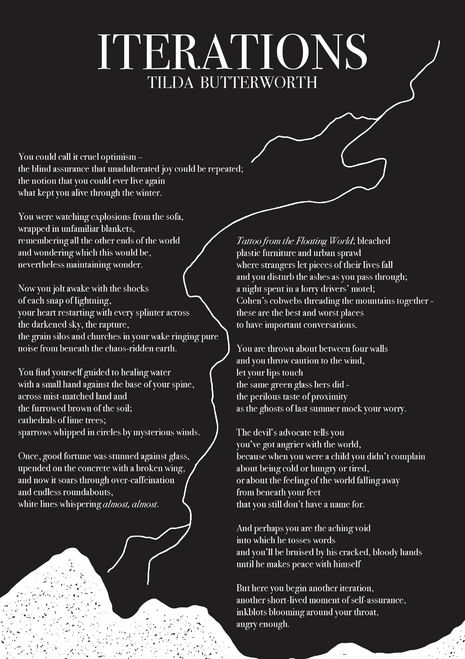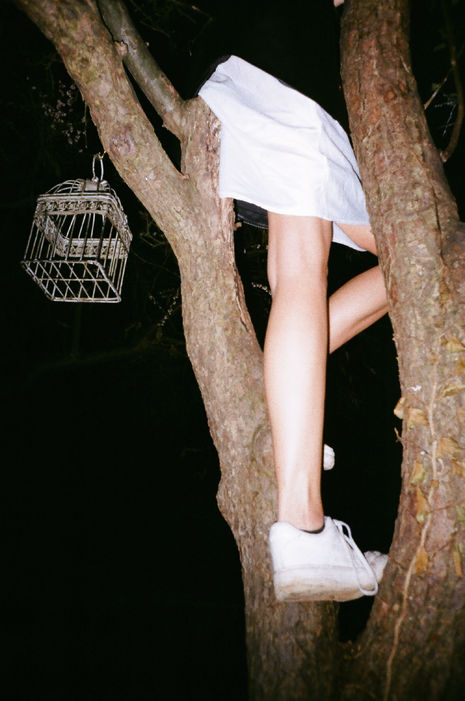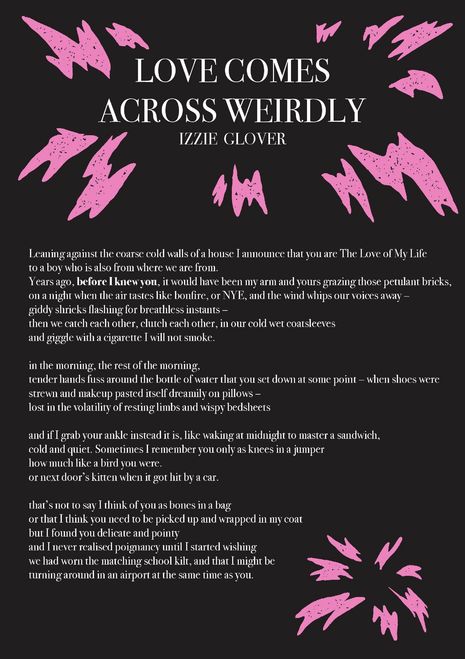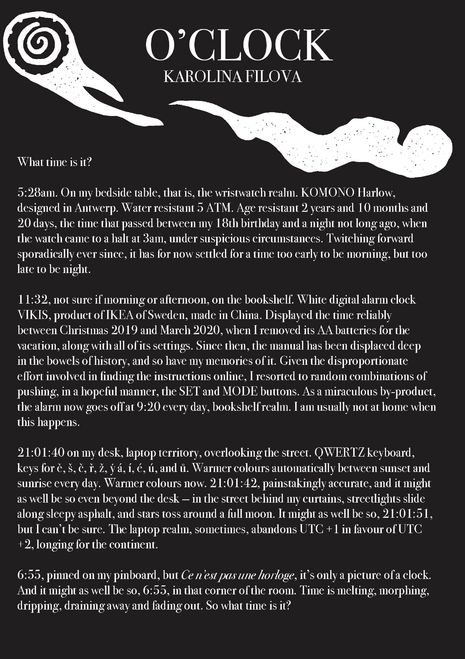Central to the Cambridge arts scene is the zine, a carefully sourced collection of work by Cambridge students. However, when Tilda Butterworth took over The Cambridge Cult in the midst of global panic and anxiety-ridden ‘Camfesses’, following the Cambridge tradition was not the goal. Instead, the zine opened its platform to international contributors and, in doing so, extended the zine’s meaning beyond just providing an outlet for Cambridge voices to express themselves on the subject of ‘chaos’. For the first time, a Cambridge zine found its position within a global context. Sitting down (virtually) with Tilda, I intended to discover more about the impulse guiding her editing process, especially considering our current overwhelming environment that impresses itself on seemingly all creative output.
The ‘buzzword’ of 2020: Chaos
Chaos, it seems, is the defining characteristic of 2020. How did 2020 influence your decision to choose this theme for the first edition?
I honestly barely had to think about the theme for my first issue as editor – the idea came to me very quickly. “Chaos” was such a buzzword in 2020, as a way of encompassing what was unfolding around us, which felt impossible to explain in any other way. The “unprecedented times” produced an environment in which it was quite impossible (at least for me) to create any art or writing that was coherent and didn’t feel utterly scattered. I wanted potential contributors to know that whatever chaos 2020 caused them to produce or create, we wanted it.
“I wanted potential contributors to know that whatever chaos 2020 caused them to produce or create, we wanted it.”

Do you think your next edition, or those after that, will be inherently different to this one as the context it is produced in changes?
I think that, had this issue not been created during a pandemic, the content of the work would have been very different. The overwhelming feelings you get while reading or looking at the work are nostalgia and frustration. There was a lot of poetry which reminisced about human intimacy, as well as work about the feelings of imprisonment caused by self-isolation. I think it was overall well-balanced, although for the next issue I’d like to see more work which focusses on current affairs other than Covid-19. In addition, I would love to eventually (when restrictions allow it) become more ambitious with our photoshoots. Larger groups of models, more public places – all of the things that seem quite impossible for the creative world right now.

What was your inspiration for the aesthetic you wanted to achieve with the zine?
My fellow editor, Charis Taplin, helped a lot in the process of assembling our Chaos moodboard, which I shared via social media. The zine itself ended up being very multi-coloured, but if you look at our moodboard, I think it’s predominantly dark and earthy tones which we preferred – and lots of candles. We were very inspired by creatives such as Florence Welch, Junglepussy and Rico Nasty in terms of their aesthetics. Ren Hang was a big influence on the analogue photography included in the zine. Other than that, Czech avant-garde cinema and the films of David Lynch were definitely on my mind. And the aesthetic of The Craft (the film itself is not great).

The cult itself is wide-ranging, with a number of contributions from outside Cambridge and even the UK. How does this fundamentally alter your approach to the ‘typical Cambridge zine’?
I always felt like the zine community in Cambridge was quite insular. This isn’t a bad thing, because of course it’s great to have a means of bringing together creatives in the same city. However, beyond Cambridge, I have many artist friends in Europe who I wanted to work with, and I had always dreamed about having all of their work somehow compiled. I’m very upset by the way Brexit is quickly isolating the UK, so I feel that any bridges we can build are so important. A moment that made me happy was when I delivered a print issue to one of the contributors, and he flipped through it and said, “It feels very Berlin!” This is perhaps unsurprising given that several of the contributors are Berliners (including columnist Greta Markurt, who did all of the wonderful page illustrations), but I love that it immediately comes across!
“I’m very upset by the way Brexit is quickly isolating the UK, so I feel that any bridges we can build are so important.”

Many people, especially freshers, are intimidated by the Cambridge zine scene, the bigger publications in particular. What do you have to say to these students, and what would you say characterises what you look for in a submission?
It is pretty intimidating, and I certainly feel like that when I submit to other zines. I would say that a rejection is not a judgement of your style, or ability, or of you as a person. I know it can feel like a personal critique, but in the end, it comes down to what the zine editors are specifically looking for. The main things I look for are a deep sense of emotion running through the piece, and a feeling of commitment to what you have created.

With a zine under the theme of chaos, it seems inevitable for something to go wrong. What proved to be the biggest difficulty in constructing the publication?
Oh, there were so many difficulties. The biggest, for me, was having to be ruthless – every time I rejected someone’s work, I felt terrible. Also, the spelling mistakes and minor errors once I put everything into InDesign! I did almost all of the Cult admin late at night after finishing essays, and so many mistakes slipped through. Almost all of them got corrected but sorting all of that out was a pretty lengthy and anxiety-inducing process.
Let us take a look into the future. Have you decided on a new theme?
Yes! You heard it here first: the theme for Issue V is ROOTS. It was a close contest with other themes which may well appear in the future, but this one felt best for now.
“Roots are below the surface and unseen, and yet they nourish and provide stability.”

From chaos to roots… there is something grounding in the new theme, perhaps reflecting a subtle hope for 2021. How did you decide on it? How do you think it will be received by the writers?
The sense of hope and grounding was definitely a factor in the decision. Roots are below the surface and unseen, and yet they nourish and provide stability. There’s also the definition of “root” as a base cause (eg. the root of all evil… take from that what you will), or origin (for Issue V I would love to see more autobiographical prose). ROOTS provides the potential to create work about people, places, nature, and anything which makes you feel connected to this earth. Bizarrely, the idea actually came from a dream I had, in which underground trains wove between the roots of trees. I like that there is the potential for surreal artwork!
Shared expression, without borders
In curating The Cambridge Cult (Issue IV: Chaos), Tilda shaped it into a recognisable product of its time. What I believe distinguishes it from other zines is its ability to reflect a global response to shared misfortune, developing this into an international time capsule. The zine urges us to remember what we need most right now: shared expression without borders.
If you want to download Issue IV: Chaos, you can do this here with or without a small donation.
If you want to contribute to Issue V: Roots, you can follow The Cambridge Cult on Instagram, (@thecambridgecult) or Facebook (The Cambridge Cult), to keep an eye out for announcements.


